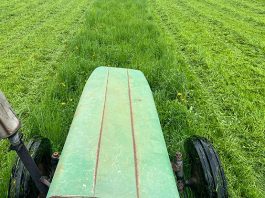Over the fall and winter we’re going to help you think about how you time grazing to manage weeds or plants you’d like fewer of. So here’s the first in the series.
Yellow starthistle arrived in California around 1849 in a load of Chilean-grown alfalfa seed (called Chilean clover back then). A 2002 map showed it on 14 million acres in California, making it the state’s most wide-spread weed. But it hasn’t stopped there. It has continued to spread across the United States.
 With its 2-inch long spines, you might think that it’s not a plant that livestock would graze. But studies have shown that cattle, goats and sheep can and will graze yellow starthistle, and, as a group of researchers from the University of California Davis demonstrated, when we time their grazing appropriately, they can actually help control it. Here’s what the results of their three years of grazing trials with cows, goats and sheep show.
With its 2-inch long spines, you might think that it’s not a plant that livestock would graze. But studies have shown that cattle, goats and sheep can and will graze yellow starthistle, and, as a group of researchers from the University of California Davis demonstrated, when we time their grazing appropriately, they can actually help control it. Here’s what the results of their three years of grazing trials with cows, goats and sheep show.
Don’t Graze Too Early
Repeated grazing of yellow starthistle in the rosette stage (March to May in California) made more yellow starthistle. In response to grazing, it produced even more flowers. Meanwhile, other plants in the pasture were grazed too hard and so they did not recover. This left even more space and water for yellow starthistle to spread. The researchers noted that “Even under drought conditions, yellow starthistle has a tremendous capacity to regrow, far exceeding other associated species. This resilience is partially due to its deep taproot, and is an important reason why yellow starthistle is so abundant on winter and spring grazed rangelands.”
Time Grazing to Protect Preferred Plants
The best time to graze yellow starthistle is in its bolting, pre-spiny stage. First, starthistle is less able to recover as summer temperatures heat up and soil moisture decreases. Second, animals will choose starthistle at this time because it’s still green and growing while other vegetation has already matured and dried. Because repeated grazing puts more stress on the plant, the researchers even ran livestock through three and four times during this period without harming the preferred forages. Those plants, having completed their life cycle, simply dropped their seeds and provided residue on the soil surface.
Grazing at this stage reduced canopy size, flowerhead and seed production, and decreased starthistle densities. The number of times a pasture was grazed depended on late-season rainfall and soil moisture levels. Higher levels of both meant more grazing repetitions. Meanwhile, they found no differences based on whether it was cattle, sheep or goats doing the grazing. The only time goats seemed better at their job was when the plant is in its spiny stage. At that stage, sheep and cows ate less of the plant. If you’re a land manager interested in bringing in livestock to graze yellow starthistle, the researchers suggested you choose the type of animal based on availability, the size of the infestation, and other site factors.
Mowing as Management Tool

Mowing can also control yellow starthistle based on the researchers test results. They found it was most effective when they during the early flowering stage and followed it up with a second mowing when the regrowth flowered again. As with grazing, this late mowing allowed other pasture plants to set seed for next season’s regrowth, giving them a competitive advantage over the starthistle.
Grazing Won’t Eliminate Yellow Starthistle
Yellow starthistle’s competitive characteristics, (large seed output, rapid germination and seedling development and quick regrowth after grazing or mowing) will make it impossible for us to eliminate it in places where it has large populations. Still, at 8 – 14% protein, it could make a good forage. So it’s worth it to practice grazing that takes advantage of it as a forage while protecting and encouraging the rest of your pasture plants.
WARNING
Yellow starthistle and Russian knapweed both cause chewing disease in horses.
The good news is that horses must eat a great deal of these plants before they are poisoned. For Russian knapweed, they must consume 59 to 71 percent of their bodyweight over 28 to 35 days to produce disease, or 86 to 200 percent for yellow starthistle. The bad news is that the toxin is cumulative over time.
Signs of poisoning include inability to swallow, drowsiness, an inability to eat and drink, frequent yawning and chewing motions with nothing in the mouth, acting as though something is caught in the throat, and chewing food and spitting it out.
There is no treatment and once symptoms are apparent, affected animals will die.







Kathy – Are you aware of any cattle grazing studies to control teasel?
Kirk, I looked and looked and found no real study. BUT, I did find something in the Congressional Record from 1945 about using salt to get cattle to eat weeds and seemed it helped with teasel. I’m going to run an article on what I found.
Comments are closed.